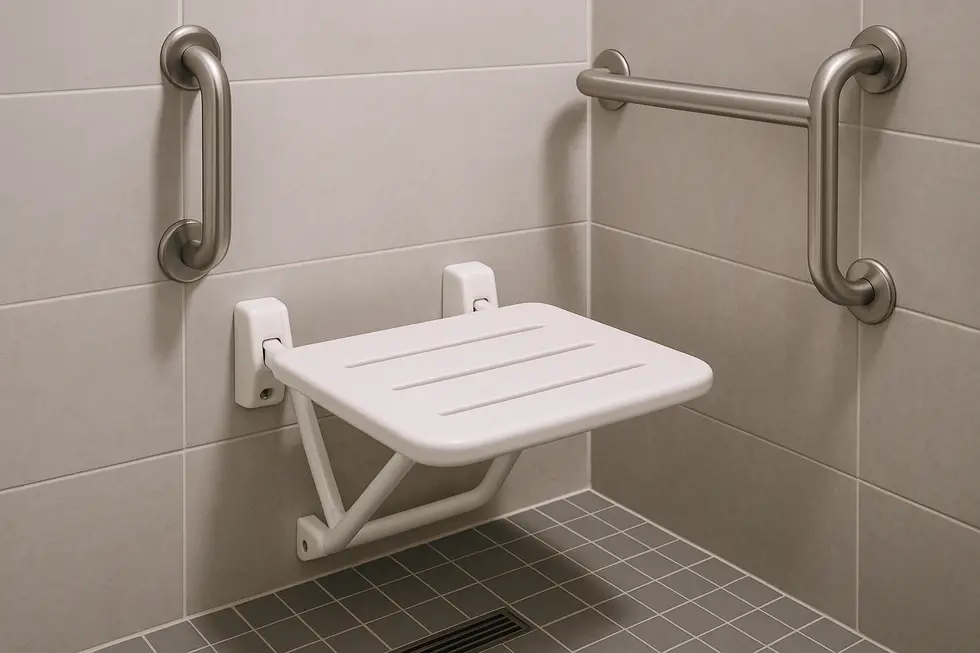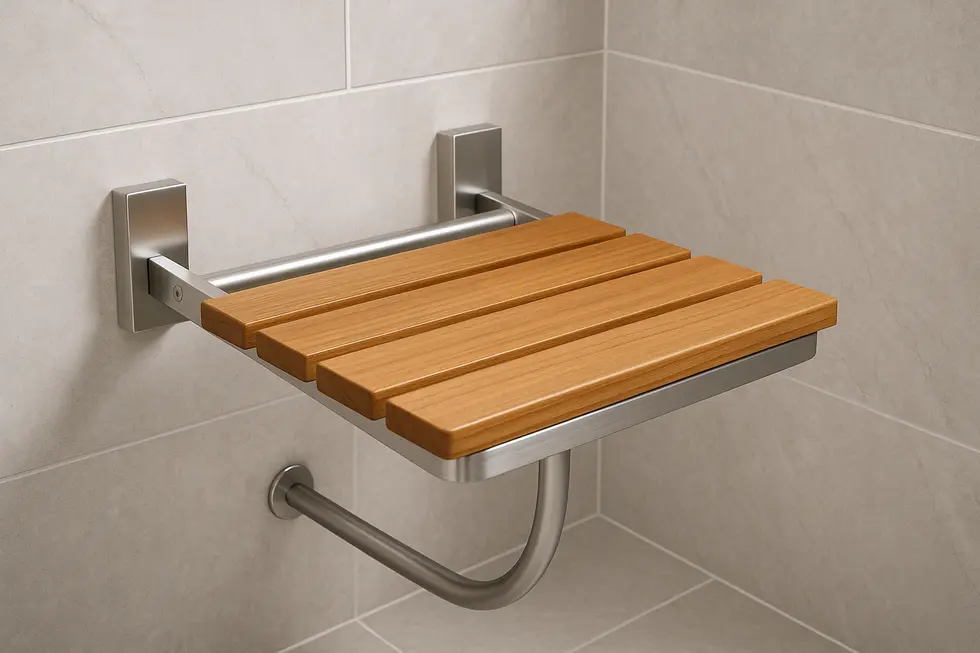Shower Seat
Enhancing Safety and Efficiency: The Role of Hospital Wall-Mounted Shower Seats
Hospital wall-mounted shower seats offer a crucial solution in healthcare settings, merging safety, accessibility, and space-saving design. These seats serve those with mobility challenges, ensuring comfort and independence during bathing. Each chapter will delve into different facets—safety standards, material innovations, and best practices for installation and maintenance—offering a comprehensive understanding of their importance in maintaining hygienic and accessible hospital environments.
Engineering Safety: How Hospital Wall-Mounted Shower Seats Satisfy Rigorous Codes and Protect Patients

Hospital bathrooms are unforgiving environments: steam, detergents, and constant traffic accelerate wear, while frail users rely on every fixture for stability. For wall-mounted shower seats, safety therefore begins at the molecular level. Frames forged from 304 stainless steel or anodized aluminum shrug off corrosion that would silently weaken ordinary mild steel. Laboratory salt-spray tests replicate years of exposure in just days, certifying that the hinge mechanism will not seize or rust-flake into sharp edges.
Performance testing then shifts to brute force. Before a seat ever reaches a patient room it must endure static loads of 300 lb (136 kg) and sudden impact drops that mimic a user plopping down without control. Only hinges that survive thousands of fold-and-unfold cycles pass durability protocols common to EN 12182 and similar standards. These requirements dovetail with U.S. ADA guidance, which also mandates that folded seats leave ample clearance for wheelchairs and for caregivers who assist from the side. Meeting ADA does more than avoid citations; it forces designers to think ergonomically. Proper seat height—generally 17–19 in. above the shower floor—keeps knees at a right angle, easing transfers and reducing shear on skin.
Surface engineering matters just as much as metal strength. A high-friction texture or narrow teak slat spacing channels water away while adding tactile grip, lowering slip risk even when soap film builds. Rounded front edges protect shins and calves, and the operating lever must require minimal force so arthritic hands are not strained. Where a shower plan includes grab bars, installers must hit blocking studs or concrete anchors, never drywall, to achieve the full load rating; the same solid backing is essential for seat brackets.
Hospitals also weigh reimbursement implications. When a seat is classified as durable medical equipment, its documented three-year lifespan and patient necessity can influence cost recovery calculations. Facilities that follow comprehensive checklists—like the ones in this detailed safety guide for wall-mounted shower seats—create audit trails demonstrating due diligence.
Ultimately, combining corrosion-proof materials, rigorous load testing, ergonomic geometry, and ADA-compliant installation delivers a fixture that quietly supports patient dignity every single shift (ADA Standards reference).
Beyond Steel and Plastic: How Advanced Materials and Thoughtful Design Elevate Hospital Wall-Mounted Shower Seats

Healthcare bathrooms are unforgiving places for equipment: they are humid, cleaned aggressively, and used by people whose balance can change from day to day. Material innovation answers these pressures first. Corrosion-proof alloys replace traditional mild steel, eliminating hidden rust that can weaken hinges and wall brackets. When a seat must reliably hold 250 lbs on the thousandth fold-down, this invisible strength matters more than any glossy finish. Water-resistant phenolic laminates add a second defensive layer. Unlike untreated plastics that craze or discolor under disinfectants, phenolic panels shrug off bleach and retain a non-porous surface that wipes completely clean—crucial for infection control protocols that demand rapid room turnover.
A different route to durability is treated teak. Once reserved for spa settings, teak battens now appear in acute‐care suites because natural oils inhibit mold while offering a warmer sitting surface for frail skin. Designers machine subtle gaps between each slat so rinse water drains instantly, starving biofilms of the standing moisture they need to grow.
Safety-focused design pairs these materials with purposeful geometry. Seats feature gentle front radii that prevent thigh pinch points, and an ever-so-slight backward tilt that encourages users to sit fully back against the wall, reducing forward slides. Textured, non-slip embossing—or in teak, narrow longitudinal ridges—creates micro-friction that still feels comfortable on bare skin. Fold-down mechanisms now employ counterbalanced arms rather than simple friction hinges, allowing patients with limited strength to deploy the seat with one hand. When stowed, the assembly hugs the wall at under five inches depth, a benefit explored further in our guide to folding wall-mounted seat design.
Every new detail traces back to accessibility codes: frame spacing accommodates a caregiver’s forearm for side support, while standard mounting hole patterns simplify swaps during future renovations without new drilling. The result is equipment that blends into the tiled backdrop yet quietly reinforces patient dignity—supportive, hygienic, and ready for relentless daily cycles. For readers comparing surface options, a catalogue of compact phenolic fold-up models illustrates these principles in practice (external link: https://www.wayfair.com/home-improvement/sb1/shower-chairs-bathroom-safety-c415806-a15527~59512.html).
Anchoring Confidence: Installation and Care Guidelines for Hospital Wall-Mounted Shower Seats

Properly installed and maintained, a wall-mounted shower seat transforms a slippery corner into a stable haven for patients and caregivers alike. The first rule is to think like an engineer: locate solid structure before a single screw is driven. A stud finder confirms two parallel wall studs, the only points capable of reliably bearing the 250- to 500-pound loads common to hospital-grade units. Once located, mark the mounting height—between 19.75 and 22.25 inches usually balances transfer ease with knee clearance—then drill pilot holes straight into the studs to prevent wood splitting.
Fastener choice is equally critical. Stainless-steel lag screws sized per manufacturer torque charts lock the frame in place, while generous washers spread stress over a wider surface. After tightening, run a continuous bead of mildew-resistant silicone around each bracket foot. This small step seals out moisture that might otherwise wick into drywall and silently weaken the anchor points over time.
With the seat secured, step back and test ergonomics. Can a user grasp a nearby grab bar without leaning? Does the seat fold flush against the wall, leaving at least 30 inches of clear floor space for wheelchairs? Adjustments now avert accidents later.
Maintenance follows the same spirit of vigilance. Schedule quarterly wipe-downs with pH-neutral cleaners; harsh bleach corrodes hinge pins and dulls teak battens. During the cleaning, inspect for hairline cracks in plastic pans, rust blooms on hardware, or play in the folding mechanism. A torque wrench quickly confirms that lag screws still meet factory specifications. Re-apply silicone any time caulking shows shrinkage or discoloration.
Annual documentation of these checks is more than paperwork—it can support insurance reimbursement by proving the seat meets durable medical equipment standards. Facilities lacking in-house trades staff should contract certified installers and retain invoices for compliance files.
For a pictorial walkthrough of several of these steps, our readers may consult this detailed step-by-step installation guide.
Adhering to these best practices aligns the bathroom with international assistive-product regulations such as the EU Medical Device Regulation, ensuring safety today and regulatory confidence tomorrow (https://eur-lex.europa.eu/legal-content/EN/TXT/?uri=CELEX:02017R0745-20230101).
Final thoughts
Hospital wall-mounted shower seats are essential in enhancing safety and efficiency in healthcare environments. By prioritizing safety features, innovative materials, and diligent installation and maintenance practices, these seats ensure accessibility and hygiene, catering to the needs of individuals with mobility challenges without compromising on space or design.
Experience a new standard of clean with PEGABidet—designed for comfort, safety, and independence. Join thousands who trust us to make personal care simple and dignified. Contact us contact@pegabidet.com
About us
PEGABidet is a brand owned by L.A NEXTGEN LLC, based in California. We design intuitive, hygienic, and accessible bathroom solutions that prioritize safety, dignity, and independence. Our mission is to make personal care effortless and empowering for people at every stage of life.

